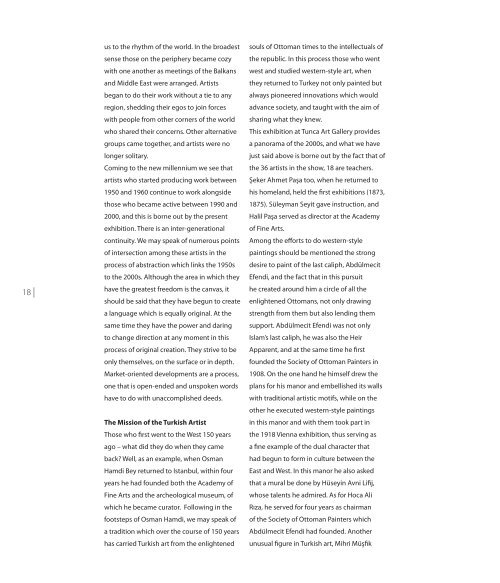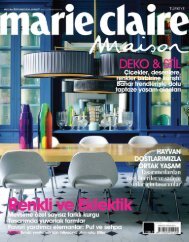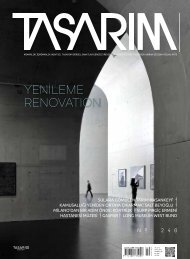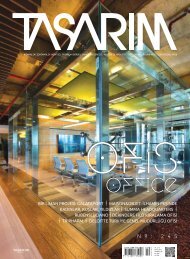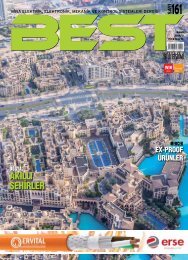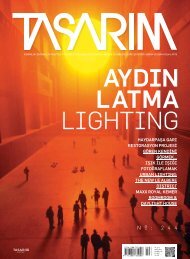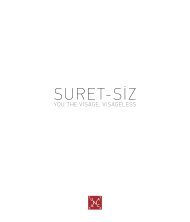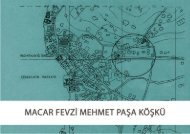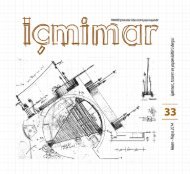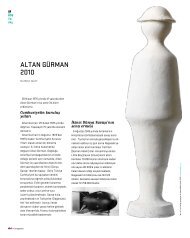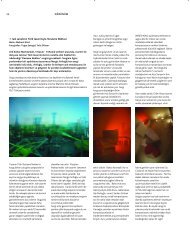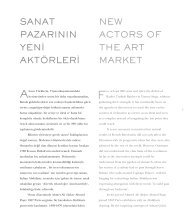YÜZEYDE VE DERİNLİKTE
Tunca Sanat’ın 17 Mayıs - 17 Haziran 2010 tarihleri arasında düzenlediği ‘’ Yüzeyde veya Derinlikte’’ adlı karma sergisi için Mahmut Nüvit'in kaleme aldığı yazısı...
Tunca Sanat’ın 17 Mayıs - 17 Haziran 2010 tarihleri
arasında düzenlediği ‘’ Yüzeyde veya Derinlikte’’ adlı karma sergisi için Mahmut Nüvit'in kaleme aldığı yazısı...
You also want an ePaper? Increase the reach of your titles
YUMPU automatically turns print PDFs into web optimized ePapers that Google loves.
18 |<br />
us to the rhythm of the world. In the broadest<br />
sense those on the periphery became cozy<br />
with one another as meetings of the Balkans<br />
and Middle East were arranged. Artists<br />
began to do their work without a tie to any<br />
region, shedding their egos to join forces<br />
with people from other corners of the world<br />
who shared their concerns. Other alternative<br />
groups came together, and artists were no<br />
longer solitary.<br />
Coming to the new millennium we see that<br />
artists who started producing work between<br />
1950 and 1960 continue to work alongside<br />
those who became active between 1990 and<br />
2000, and this is borne out by the present<br />
exhibition. There is an inter-generational<br />
continuity. We may speak of numerous points<br />
of intersection among these artists in the<br />
process of abstraction which links the 1950s<br />
to the 2000s. Although the area in which they<br />
have the greatest freedom is the canvas, it<br />
should be said that they have begun to create<br />
a language which is equally original. At the<br />
same time they have the power and daring<br />
to change direction at any moment in this<br />
process of original creation. They strive to be<br />
only themselves, on the surface or in depth.<br />
Market-oriented developments are a process,<br />
one that is open-ended and unspoken words<br />
have to do with unaccomplished deeds.<br />
The Mission of the Turkish Artist<br />
Those who first went to the West 150 years<br />
ago – what did they do when they came<br />
back? Well, as an example, when Osman<br />
Hamdi Bey returned to Istanbul, within four<br />
years he had founded both the Academy of<br />
Fine Arts and the archeological museum, of<br />
which he became curator. Following in the<br />
footsteps of Osman Hamdi, we may speak of<br />
a tradition which over the course of 150 years<br />
has carried Turkish art from the enlightened<br />
souls of Ottoman times to the intellectuals of<br />
the republic. In this process those who went<br />
west and studied western-style art, when<br />
they returned to Turkey not only painted but<br />
always pioneered innovations which would<br />
advance society, and taught with the aim of<br />
sharing what they knew.<br />
This exhibition at Tunca Art Gallery provides<br />
a panorama of the 2000s, and what we have<br />
just said above is borne out by the fact that of<br />
the 36 artists in the show, 18 are teachers.<br />
Şeker Ahmet Paşa too, when he returned to<br />
his homeland, held the first exhibitions (1873,<br />
1875). Süleyman Seyit gave instruction, and<br />
Halil Paşa served as director at the Academy<br />
of Fine Arts.<br />
Among the efforts to do western-style<br />
paintings should be mentioned the strong<br />
desire to paint of the last caliph, Abdülmecit<br />
Efendi, and the fact that in this pursuit<br />
he created around him a circle of all the<br />
enlightened Ottomans, not only drawing<br />
strength from them but also lending them<br />
support. Abdülmecit Efendi was not only<br />
Islam’s last caliph, he was also the Heir<br />
Apparent, and at the same time he first<br />
founded the Society of Ottoman Painters in<br />
1908. On the one hand he himself drew the<br />
plans for his manor and embellished its walls<br />
with traditional artistic motifs, while on the<br />
other he executed western-style paintings<br />
in this manor and with them took part in<br />
the 1918 Vienna exhibition, thus serving as<br />
a fine example of the dual character that<br />
had begun to form in culture between the<br />
East and West. In this manor he also asked<br />
that a mural be done by Hüseyin Avni Lifij,<br />
whose talents he admired. As for Hoca Ali<br />
Rıza, he served for four years as chairman<br />
of the Society of Ottoman Painters which<br />
Abdülmecit Efendi had founded. Another<br />
unusual figure in Turkish art, Mihri Müşfik


